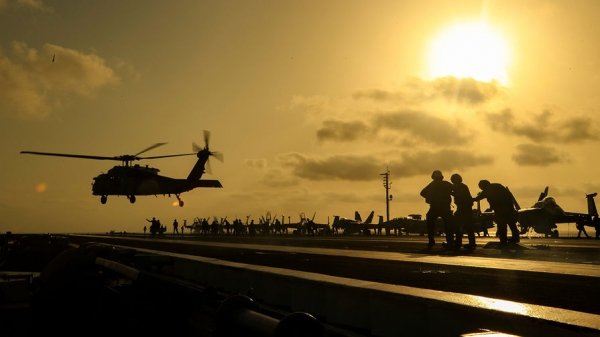
Washington and Tehran are increasingly moving into the deep confrontation. And although each side says it wants war, to eliminate hot conflict between the US and Iran, no one can.
The authoritative edition of Defense News presented its scenario of a potential US military action against Iran, this starts a script American military observers in the style of a detective.
“Late night somewhere near the coast of Iran, U.S. Navy sailors sleep after a regular watch on Board the ship. Suddenly a powerful blow rocked the hull of the vessel and wakes the sailors. Is the Iranian mini-submarine or perhaps an unmanned aerial vehicle, attacked the American ship. Means of destruction passed all boundaries of possible protection, and the water rapidly flows into the compartments of a sinking ship” — so begins Defense News.
According to the publication, then within a few hours after the incident, the Iranian leaders say that it was not a deliberate attack. However, the leaders of the Iranian Navy to hide the true picture of events from the world community.
Meanwhile, in response to Iran’s actions, the US armed forces are already starting to react.
Massive attacks of air and naval forces are applied primarily on the starting position of the missile forces of Iran, stationed along the southern coast of the Islamic Republic. The main objective of these massive missile and air strikes and bombing — to prevent any possible retaliation of Tehran against U.S. troops.
Still a full-scale armed conflict between the United States and its allies on the one hand, Iran and sympathetic to him States on the other remains is that in the realm of the possible. But tensions between Washington and Tehran is growing. The United States sent to the region, more troops, arms and military equipment, and logistical resources. And experts on strategic planning in the Pentagon and high-ranking members of the intelligence services of the USA have become more and more closely analyze what may lead to such an armed conflict.
Available forces and means Iran is likely to make the whole Persian Gulf is not available for groups of combat ships of the US Navy. The first trains starting positions of anti-aircraft missile systems and complexes of air defence of Iran will pose a serious danger to pilots of the US air force. And a large Arsenal of Iranian ballistic and cruise missiles threatens U.S. military facilities in almost the entire area of the Central command of the U.S. armed forces.
Iran in recent years has created a wide range of the missiles from ballistic missiles “Shahab-1” with a range of 300 km cruise missile “Sumar” with a stated range of 2,500 km., These products can hit targets anywhere in the Persian Gulf, Israel, Egypt, Afghanistan and other regions of southern and Eastern Europe.
Thus, a possible fee for participation in such armed conflict may be for US is prohibitive.
In addition, the vast majority of the American expert community is not clear, it may look hypothetical American victory. Nobody in the USA is currently not in favour of large-scale occupation, such as that which followed the US invasion of Iraq in 2003. And many experts warn against hopes or assumption that the massive military intervention under U.S. leadership, will force the Iranians to overthrow its Islamic regime, and to turn Iran into an American ally.
According to the Strauss Center at the University of Texas at Austin, the armed forces of Iran is about 545 thousand soldiers and officers who are on active military service and 350 thousand reservists, including about 125 thousand people in the IRGC. But at the same time, despite the fact that the total number of the Iranian armed forces is high, the quality of the army and Navy doubt. Iran is currently under sanctions and denied the opportunity to acquire Western technology.
Previously written about the fact that the military-technical power of Tehran at this stage is clearly insufficient to effectively counter such an opponent as the United States.
The pre-war situation
Earlier this month, Iranian leaders announced that they will resume the processing of uranium if other countries subscribing to in 2015 the Joint comprehensive plan of action regarding Iran’s nuclear program will not be able to find ways of easing the tough sanctions imposed by Washington after the US withdrawal from the AGREEMENT last year.
This was followed by leaked reports of upcoming military plans that could include sending to the region to 120 thousand American troops. And is the size comparable to the military army for the invasion of Iraq in 2003. This was followed by statements by the leaders of Iran and the United States, which claimed not to want war, but each of them largely is preparing for such an outcome.
Then acting Minister of defense Patrick Shanahan stated that the region sent about 900 additional troops, in addition to the already supplied batteries SAM “Patriot”.
Finally, the United States sent to the Persian Gulf carrier battle group and strategic bombers.
In some media reports alleged that the head of Iran’s proxy groups have been ordered to prepare for a number of attacks on the USA and allies across the Middle East. They involve some Shiite groups in the region, but not all, as some of them are linked with Iran, but others are based on their own considerations and needs.
How will the conflict
The American edition of Military Times surveyed more than a dozen military experts, including current and former military officials in the Pentagon about how can start a conflict and how it can end. Here are the opinions of American experts on this issue.
In key transit points like the Suez canal and the Strait of Hormuz, there can be terrorist acts carried out by suicide-jihadists. Waters of the Indian ocean near Yemen will be crammed with sea mines, which will make crossing the sea in this region for any vehicle almost suicidal RAID.
The leaders of the United States and Iran, will broadcast his bellicose rhetoric through all available media. While both Washington and Tehran are pointing at each other and say that neither side wants war.
Crowds of supporters gathered around Iran’s diplomatic missions in the middle East, first throwing stones and then going to undermine Shahid-mobiles.
US troops take up battle position or withdrawn to a fortified base in the partner countries. Cyber-attacks follow one another, resulting in a shutdown of the entire grid.
Few American and allied units of the special operations Forces are on the territory of Iran and destroy high-profile targets and objects of the Islamic Republic.
In this case, most likely, according to U.S. experts, the existing political regime in Iran is not going anywhere and will remain in place. Weakened by the war the nation will seek to restore its position. And Tehran’s nuclear programme starts again.
War at sea
Instead of directly to fight with the U.S. Navy, Iran uses whole swarms of small boats, unmanned aerial vehicles and sea mines to effectively counter the us Navy, especially in places like the Strait of Hormuz, a key corridor connecting the Persian Gulf with the Gulf of Oman.
In addition, one of the threats for the US Navy in the region is the new Iranian submarine class “Fatah” (“Fateh”), having a length of 40 m at the waterline. The submarine is armed with missiles “ground-ground” with a range of about 2000 km.
Another threat to the American fleet in the Persian Gulf — a mini-submarine class “Gadir” (“Ghadir”). In Iran there are approximately 23 115-ton submarines. Submarine of this type is in service with the Navy of the Islamic Republic since 2007. Displacement — 120 tons, length — 29 m, width 3 m, height — 2.5 m, speed — 11 knots, crew — 18 people. The boat is armed with two torpedo tubes and mines.
“Submarines “Gadir” have small size, so easily can work under water in the shallow Persian Gulf. Iranian submarines very difficult to detect with sonar, as they are low noise when moving with batteries”,
— said Brian Clark, a former submariner and senior assistant to the chief of naval operations and now an analyst at the Center for strategic and budgetary assessments. According to him, the relatively small size of the Persian Gulf limit for ships of the U.S. Navy response to such attacks.
However, it is unclear for what reasons, the American experts did not mention other subs available on the equipment of the Iranian Navy. These include the Russian-built submarine project 877ЭКМ, boats Al-Sabetah, Qaaem, Nahang. In addition, the equipment of the naval forces of Iran consist of a North Korean mini-submarine Yugo class.
In addition, Tehran has corvettes 1 and 2 rank and a considerable number of missile boats.
If the Iranian Navy will inflict even minor damage, the U.S. Navy, in the eyes of the world, such actions will look like a major victory, concur in the opinion of the American experts.
Experts believe Defense News, in the confrontation with Iran will find the use of such weapons systems the U.S. Navy as a shipboard anti-aircraft missile RIM-116 a direct protection of the ship, missiles such as Standard Missile and anti-aircraft guided missile RIM-7P (Evolved Sea Sparrow).
During the invasion of Iraq in 2003, the United States sent to the Persian Gulf and surrounding waters a whole Armada of ships, the US Navy’s five aircraft carrier battle groups, battleships, cruisers and destroyers, amphibious task group. According to Clark, this kind of transaction for Iran to be unlikely.
But any large-scale conflict is likely to require at least three aircraft carrier battle aircraft carrier, to liberate US from the restrictions imposed by the countries-allies in the region on the use of aircraft from land aerodromes, says Brian Clark.
Unlike the war in Iraq, the strikes can be applied with the waters of the Arabian sea, not only from the Persian Gulf, if the main targets will be located on the southern coast of Iran, near the Strait of Hormuz, opposite of Oman.
Battles on land
Of course, the US army will play a vital role in any conflict in the region, but without any real plans for the immediate invasion of Iran. Any attempt to imagine a future conflict between Washington and Tehran as slender columns “Stryker”, “Abrams” and “Humvee” marching through the Iranian desert that look like paintings, very detached from life.
Expected invasion of major groups of land forces of the United States on the territory of Iran does not follow.
Instead, the army will create a working network, which will include anti-aircraft missile batteries “Patriot” rocket system of volley fire type HIMARS (High Mobility Artillery Rocket System) on a wheeled chassis and attack helicopters to destroy targets on the territory of the Islamic Republic.
In addition, it was important to ensure the defense of major us and allied objects not only from Iranian missiles but also from proxy groups that would attack these bases in Syria, Iraq, Saudi Arabia and Kuwait.
In short, the proxy group can strike the U.S. and its allies across the region. There are many irregular units of the Pro-Iranian orientation, which should be considered when planning combat operations, and many of them are far outside Iran — in Syria, Yemen and Iraq.
Philip Smith, a research fellow at the Washington Institute, told the Military Times that a proxy group are composed of hardened in numerous battles Hizbollah, the latter has close ties with the IRGC. And they have weapons, including improved explosive devices, means of struggle with which very few even of the US army.
“If it is waged by the armed conflict between the US and Iran, it will be characterized by the massive use of precision weapons, mostly air-based, the use of a small number of departments and units of special operations Forces and large-scale offensive cyber attacks,” said Dave Deptula, Lieutenant General, retired air force, Dean of the Institute for aerospace studies. Mitchell.
USA in the upcoming conflict will be resolved by the problem of defeating the underground shelters of Iran using both conventional and nuclear weapons, which a recent Pentagon dowry properties of precision weapons.
Any work to be conducted behind enemy lines, to neutralize missile threats, disrupt lines of communication and supply or destroy the place of development of nuclear fuel will be performed by divisions and units of the special operations Forces of the United States. This will include accurate target designation, security personnel in high risk areas such as nuclear facilities, the establishment of advance airfields on the territory of Iran for the execution of deep exploration.
War in the air
Any air campaign against Iran will be very different from operations of the U.S. air force in the past, mainly because the air defense of Iran are more modern than the previous opponents of the US.
To hit anti-aircraft missiles and radar system intelligence of Iran, the United States will have to either physically destroy them or prevent their normal functioning by using electronic warfare.
To get closer to the starting position of SAM, a US air force aircraft should have a minimal radar signature.
Therefore, for the bombing of Iran will need a stealth aircraft to bypass its defense system Russian-made s-300 missiles “earth-air” Bavar 373 local production. Therefore, such actions will require extensive combat use of fighter 5 th generation F-22 and F-35, experts say Defense News.
Earlier it was written that the U.S. air force during a hypothetical war with Iran will bet on stealth in radar against the jets and strategic bombers b-2 “Spirit”.
But even more lethal means of defense Iran will not necessarily limit an air campaign conducted by the United States air force, I guess in Defense News.
According to Dave Deptula, the problems with the air defense of Iran “can be resolved”, the strikes will be “fast, brutal and decisive” lasting “days and weeks, not months and years.”
Previously written that the United States to subdue Iran will have to spend almost a full strategic aerospace operation with the involvement of a significant part of its air and naval forces. There is every reason to believe that this will be one of the options for prompt global strike, but only within the framework of the near and middle East region.
Deptula also said that currently it is difficult to achieve a truly strategic surprise action of the U.S. armed forces, as the transfer of forces to the region will not go unnoticed.
The U.S. air force is likely to begin an air campaign, more like “desert Storm” than to fight against the “Islamic state” (organization banned in Russia) in Iraq and Syria.
In such a scenario, the Iranians even with different political beliefs is likely to rally around their leaders and support the regime in the struggle against the external aggressor, say the experts.
© 2019, paradox. All rights reserved.





